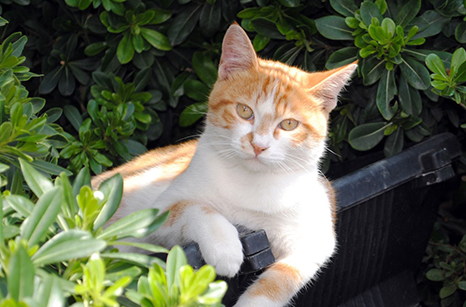
Congratulations on deciding to neuter your cat. The benefits to yourpets health and helping to reduce the pet overpopulation crisis makes this decision easier. Neutering is the common term used to describe the surgical procedure known scientifically as orchidectomy or orchiectomy. Neutering
is very beneficial to the health of the cat, especially if performed at an early age. Following puberty, which occurs at approximately 8 to 9 months of age, the male cat often develops a number of undesirable behavioral changes. He will become territorial and start to mark areas, even inside the
house, by spraying urine. This urine has a particularly offensive odour and is difficult to remove. As the tomcat reaches sexual maturity, he will start to enlarge his territory, straying even farther from the house, particularly atnight. It is for this reason that many of the cats that are hit byautomobiles are non-neutered males. By increasing the size of his territory, he increases the likelihood that he will come in contact with other cats and will get into fights for territorial dominance. Inflicted fight wounds can result in severe infections and abscesses. Diseases such as FIV(Feline Immunodeficiency Virus) and FeLV(Feline Leukemia), which can cause AIDS-like syndromes and cancers in cats, are spread through cat bites. These cats are most commonly affected by such incurable diseases. The
longer a tomcat sprays and fights, the less likely neutering will stop these behaviours. Last, but not least, neutering your cat can help prevent needless deaths of tens of millions kittens and cats each year.
In most cases, it is recommended to neuter your cat before the onset of puberty. Puberty normally begins between 6 and 10 months of age. We recommend neutering your cat at around 6 months of age.
A cat neuter is considered a major surgical procedure that requires a general anaesthetic. Whenyour cat is admitted for surgery, he will beexamined by the veterinarian performing the surgery, and pre-anaesthetic blood tests will be performed if you have chosen to do so. Your cat is
anaesthetized, and then both of the testicles are removed through two small incisions in the scrotum. Since the incisions are very small, and since stitches may cause irritation of the sensitive skin of the scrotum, it is rare for the incisions to be sutured. We use a skin adhesive to hold the incision closed
while it heals. Laser Therapy is performed on incisions post-operatively.
In general, complications are rare during the neutering of cats. With modern anaesthetics and monitoring equipment, the risk is very low. However, as with all surgical procedures, there is always a small risk:
- Anaesthetic Complication– It is always possible that any pet could have an adverse reaction following the administration of any drug. Such cases are impossible to predict, but fortunately are extremely rare. Pre-operative bloodwork is a useful screening test that may detect pre-existing problems which could interfere with your pets ability to handle anaesthetic drugs.
It is important that you properly fast your cat prior to surgery according to our instructions. In addition, any signs of illness or previous medical history should be reported to us prior to any sedation, anaesthesia or surgery.
- Post Operative Infection– This may occur internally or around the incision wound. In most cases the infection can be controlled with antibiotics. This most commonly occurs when the cat licks the site excessively or is in a damp environment.
In the vast majority of cases, no adverse affects are noted followingneutering. In certain cats, notably the Siamese breed, the hair that grows back over an operation site may be noticeably darker, believed to be due to a difference in the skin temperature. This darker patch may grow out with the following molt as the hair is naturally replaced. There are many myths and rumors about neutering that are not supported by facts or research. Be sure to address any questions or concerns you may have with your veterinarian prior to surgery.
BENEFITS TO IV FLUIDS FOR ANAESTHESIA & SURGERY
- Intravenous fluids help to maintain normal blood pressure under anaesthesia.
- Intravenous fluids provide venous access in emergency situations and help keep the organs perfused.
- Intravenous fluids result in a more stable anaesthesia, and a quicker recovery for our patients.
BENEFITS TO POST OPERATIVE LASER THERAPY
Laser Therapy reduces pain and inflammation, stimulates nerve regeneration, muscle relaxation and immune system response. This significantly reduces healing time.
WHY LASER SURGERY?
- LESS PAIN – Laser energy seals nerve endings as it moves through tissue. Your pet feels less pain post-operatively.
- LESS BLEEDING – The laser seals small blood vessels during surgery which allows us to perform surgeries with extraordinary precision. This also speeds some procedures reducing the amount of anesthesia needed.
- LESS SWELLING – Laser energy does not crush, tear or bruise because only a beam of intense light contacts the tissue.


